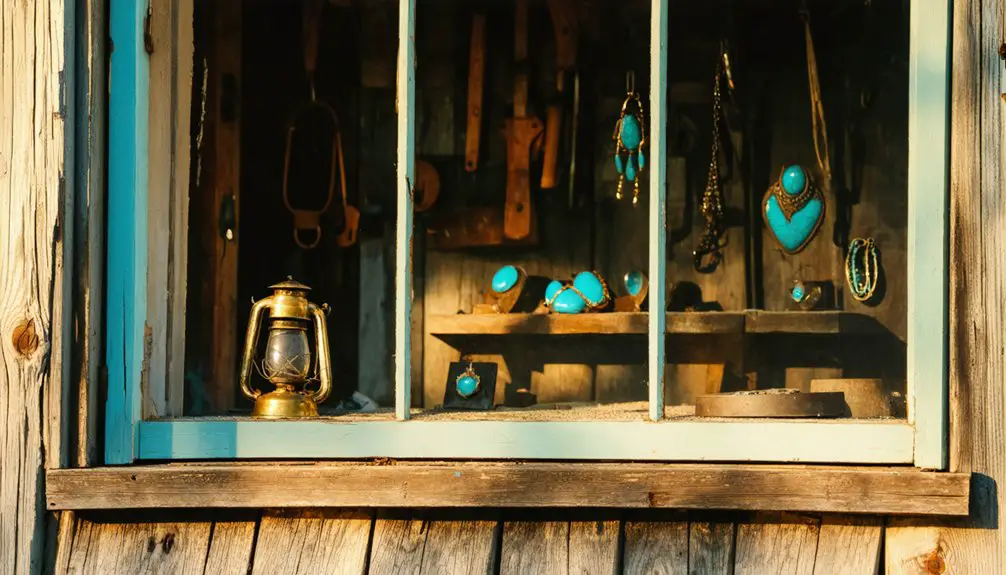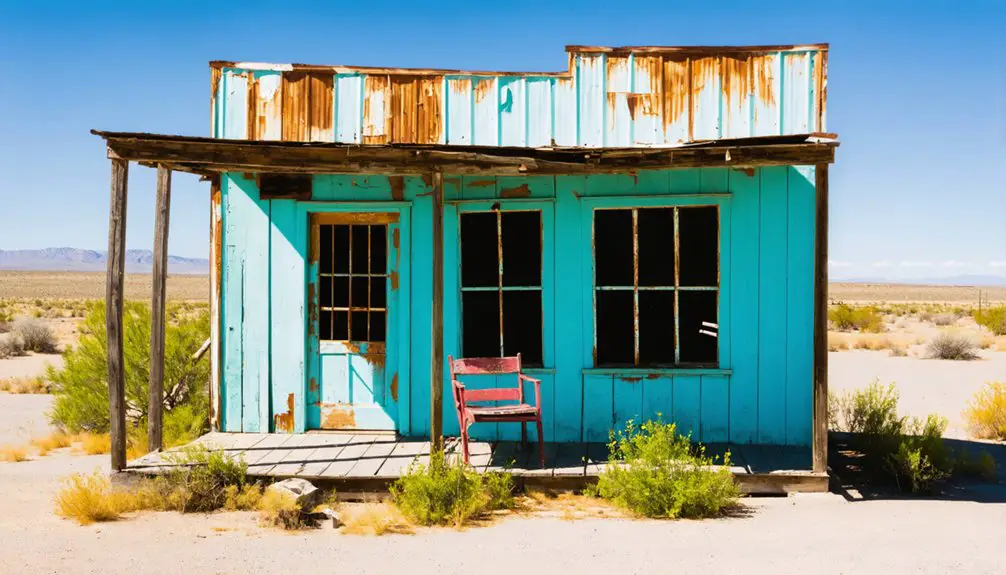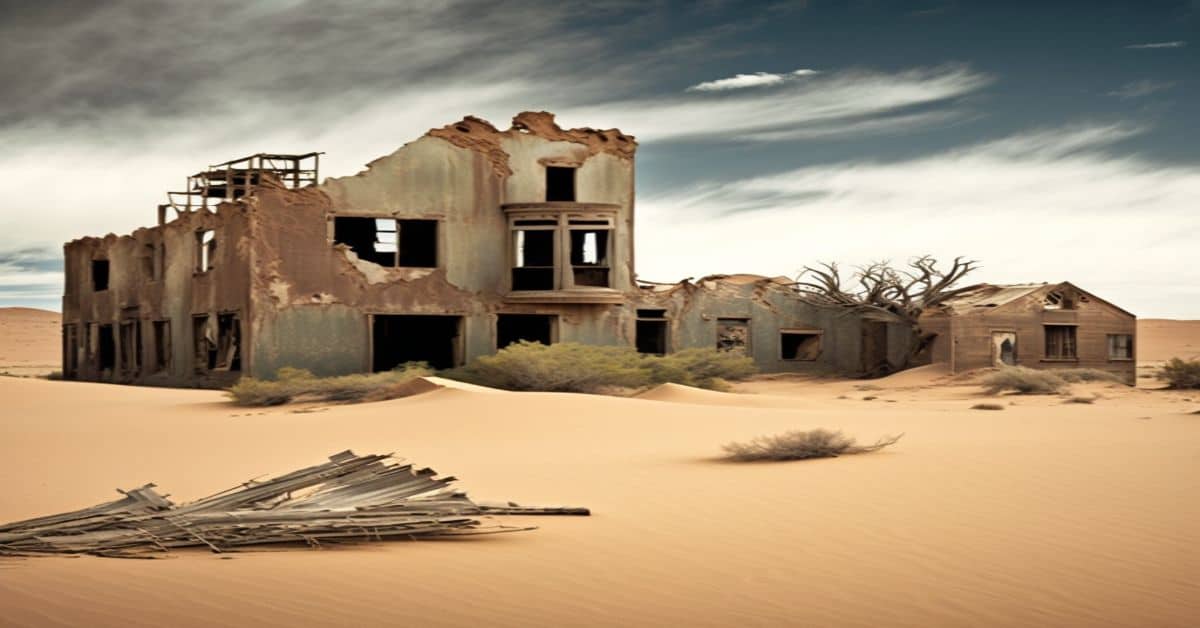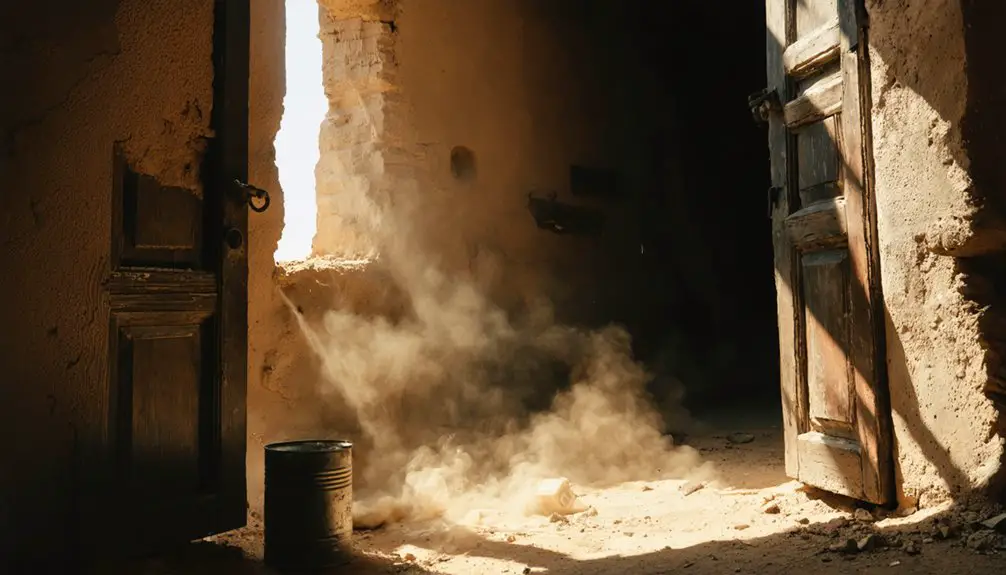You’ll find Madrid, New Mexico’s transformation from bustling coal town to creative oasis intriguing. After gold’s discovery in 1869 and coal in the 1890s, the population soared to 3,000 during peak mining years. When operations ceased in the 1950s, the town emptied until artists revitalized it in the 1970s. Now home to 400 residents, Madrid’s historic buildings house 40+ galleries and studios, while supernatural tales and mining artifacts reveal deeper layers of its intriguing story.
Key Takeaways
- Madrid transformed from an abandoned mining town in the 1970s into a thriving artistic community with 400 residents and 40 businesses.
- The town features preserved mining artifacts from its peak coal-mining era, including a 1901 Richmond Steam locomotive and original carts.
- Unlike typical ghost towns, Madrid maintains active galleries, shops, and the Mine Shaft Tavern, attracting tourists year-round.
- Historic buildings from the mining era have been repurposed into art studios and galleries along Main Street.
- The town reportedly harbors supernatural activity, with ghost sightings at the Mine Shaft Tavern and Java Junction café.
The Rise and Fall of a Coal Mining Empire
While early prospectors initially found gold in the area in 1869, Madrid’s true destiny emerged when rich coal deposits were discovered in the 1890s.
You’ll find the town’s coal mining legacy began with a 6.5-mile railroad spur constructed in 1892, connecting the settlement to the Santa Fe Railroad. By 1893, Madrid’s population swelled to 2,500 as miners and their families settled into wood-framed cabins transported by train.
The Albuquerque and Cerrillos Coal Company transformed Madrid into a thriving company town by 1906, supporting 3,000 residents. During World War II, the company became a crucial supplier as Los Alamos became their primary customer.
Under the Albuquerque and Cerrillos Coal Company’s stewardship, Madrid flourished as a bustling company town, becoming home to thousands.
Community dynamics centered around company-owned infrastructure, including housing, schools, and a power plant. Under Oscar Huber’s leadership, the town saw significant improvements including paved streets and a new hospital.
Coal production peaked in 1928 with 180,000 tons shipped annually, but post-World War II natural gas adoption led to Madrid’s decline.
A Ghost Town’s Remarkable Renaissance
After decades of abandonment, Madrid experienced a remarkable transformation beginning in the 1970s when artists and free spirits discovered its potential.
You’ll find how this artistic revival turned abandoned mining buildings into vibrant studios, galleries, and shops, breathing new life into the historic town. The town once thrived on coal mining operations until the transition to natural gas led to closures.
The population stabilized at 400 residents, with artists, craftspeople, and cultural innovators establishing over 40 creative businesses. The community takes pride in organizing annual festivals like the Christmas Parade and He She Bang drag show.
Through community collaboration, they’ve preserved the town’s mining heritage while forging a new identity.
Today, you can explore the Mine Shaft Tavern for live music, browse unique galleries, or visit Maggie’s Diner, a popular film location.
Madrid’s success story shows how a ghost town can reinvent itself through cultural tourism while maintaining its authentic spirit.
Haunted Tales From the Mine Shaft Tavern
The Mine Shaft Tavern’s haunted legacy stretches back to its 1897 origins as a miners’ bar in Madrid.
After a 1947 fire, it was rebuilt with a massive 40-foot pine counter where coal miners would gather after their shifts.
You’ll find the tavern’s connection to the Manhattan Project adds a darker dimension to its spectral tales.
Today, you can experience ghostly encounters firsthand, from mysteriously falling glasses to unexplained apparitions that seem to favor certain visitors.
The tavern’s tunnel entrance and historic wooden structures create the perfect backdrop for paranormal activity.
While ghost hunters frequently investigate the premises, the haunting has become interwoven with Madrid’s cultural fabric.
Staff members regularly report seeing reflections in mirrors that seem to show the ghost of Madaline watching them.
The tavern serves as both a reflection of the town’s mining heritage and a gathering place where locals and tourists share their supernatural experiences.
Visitors often leave their mark by adding decorated dollar bills to the tavern’s unique wall display.
Artistic Spirit Transforms Historic Streets
You’ll find Madrid’s transformation began in the 1970s when artists discovered abandoned mining homes and established creative spaces along Main Street.
The artistic community has grown to include over 40 galleries, featuring everything from pottery and handcrafted jewelry to vintage art and mixed media installations. These shops and galleries occupy former miners’ shacks that once housed coal workers during the town’s peak. The unique spirit of Madrid is protected through landowners association bylaws that prevent corporate chains from entering the community.
Today, the restored wooden row houses stand as colorful examples to Madrid’s evolution from ghost town to thriving art hub, where hundreds of visitors explore the galleries and shops within walking distance.
Creative Haven Emerges
While Madrid’s coal mining industry crumbled in the 1950s, an unexpected artistic renaissance emerged in the 1970s as creative pioneers discovered the town’s potential.
You’ll find the transformation began when artists like Diana and Mel Johnson seized opportunities in abandoned miners’ cabins and wooden buildings along Main Street, drawn by affordable rent and the promise of creative freedom.
Today, you can explore nearly 40 galleries and studios within walking distance, where artist collaboration thrives in repurposed historic structures. The renowned green-chile cheeseburger at the Mine Shaft Tavern keeps visitors coming back for more.
Glass workshops, pottery studios, and community workshops breathe new life into the town’s weathered buildings. The Mine Shaft Tavern anchors the social scene, while venues showcase multicultural and folk art themes. During winter, the town dazzles visitors with its signature year-round Christmas lights display.
Second-generation creators like Riana Peaker-Newman continue their families’ legacies, ensuring Madrid’s artistic spirit evolves while honoring its mining heritage.
Galleries Shape Town Identity
Galleries now dominate Madrid’s Main Street, with nearly 40 artistic spaces inhabiting the town’s historic row houses and mining-era buildings.
You’ll find a rich gallery diversity, from Johnsons of Madrid, established in 1973, to newer ventures like Calliope Art Gallery, opened in 2018. These spaces showcase everything from fine art to handcrafted jewelry and pottery.
The galleries’ wooden architecture sets Madrid apart from adobe-dominated towns like Santa Fe and Taos, creating a distinctive visual identity that’s both eccentric and authentic.
Through artistic collaboration, these spaces serve as more than just showrooms – they’re community hubs where you’ll discover art classes, workshops, and cultural events.
The creative economy they’ve spawned has transformed Madrid from a ghost town into a thriving artistic destination, while maintaining its unique character.
Hidden Gems Along the Turquoise Trail

Beyond the well-known attractions of the Turquoise Trail lie hidden treasures waiting to be discovered.
You’ll find artistic workshops tucked away in historic buildings and hidden boutiques showcasing unique local crafts throughout Madrid and neighboring towns.
- Venture into Cerrillos Hills State Park to explore ancient turquoise mines and walk trails where Native Americans once gathered precious stones.
- Stop at family-run Burger Boy, serving authentic New Mexican flavors for over four decades.
- Visit Roadrunner Studio and Gallery to witness metal and glass artists crafting their masterpieces.
The trail’s rich cultural tapestry extends through Golden and Cerrillos, where you can experience horseback riding on Tennessee Walkers, browse specialty shops filled with handcrafted jewelry, and discover secluded spots perfect for photographing the high desert landscape.
Preserving Madrid’s Mining Heritage
You’ll find extensive collections of mining equipment and artifacts at Madrid’s Old Coal Town Museum, where Edison’s Ediphone and innovative 50-gallon drum mine cars demonstrate the town’s technological advancement through the coal mining era.
The museum’s educational programs show how Madrid’s miners extracted both standard and valuable anthracite coal from the 30-square-mile deposit that fueled the town’s growth to 2,500 residents.
Through preserved mining sites and carefully maintained historical structures, you can experience firsthand how this once-bustling coal town operated from the 1880s until its decline in the 1950s.
Historic Mining Equipment Displays
The Madrid Old Coal Town Museum houses an extensive collection of mining equipment that chronicles the town’s industrial heritage from the 1800s through its peak coal-mining era.
You’ll find historic artifacts ranging from hand tools to mechanized equipment, showcasing the evolution of mining technology. The museum’s collection includes rare pieces like Edison’s Ediphone and one of New Mexico’s earliest X-ray machines.
Experience these remarkable mining innovations:
- A preserved 1901 Richmond Steam locomotive that once hauled coal through the mines
- Ingeniously crafted 50-gallon drums converted into one-man train cars
- Original mining carts that transported coal along the 4-mile railroad network into nearby hills
These displays tell the story of Madrid’s transformation from soft coal extraction to the prized anthracite mining that fueled the region’s growth.
Coal Production Teaching Methods
While artifacts housed in the museum showcase Madrid’s physical mining legacy, dedicated educational programs now bring the town’s rich coal mining history to life for new generations.
You’ll discover how coal mining education interweaves environmental studies with historical significance through hands-on experiences at abandoned mine sites. The curriculum draws from extensive documentation, including the 2010 Madrid Mining Task Report and oral histories from miners’ families, painting a vivid picture of life in this once-thriving company town.
You can explore how the AML Program’s ongoing reclamation projects serve as outdoor classrooms, demonstrating mine closure techniques and environmental protection measures.
Through these programs, you’ll learn about Madrid’s evolution from a bustling coal town of 2,500 residents to its eventual transformation when natural gas arrived in 1949.
Mining Tourism Experience Sites
Nestled within original 1890s buildings, Madrid’s Old Coal Town Museum stands as the cornerstone of the town’s mining tourism experiences.
You’ll discover authentic mining relics, from tools and carts to unique one-man train cars crafted from 50-gallon drums. The museum’s impact on tourism extends beyond its walls, revealing over 4 miles of mapped mining tunnels.
Experience Madrid’s mining heritage through these landmark sites:
- Oscar Huber Memorial Ballpark – the first coal-powered lighted ballpark west of the Mississippi, hosting historic night games since 1928
- Mine Shaft Tavern – a historic establishment offering mining-themed ambiance and regional cuisine
- Main Street Galleries – over 40 transformed miners’ cabins now showcase local art and craftsmanship
You’ll find interpretive walking tours connecting these sites, bringing Madrid’s mining story to life through preserved buildings and infrastructure.
From Coal Dust to Cultural Hub
Following decades of robust coal production, Madrid’s transformation into a cultural destination began taking shape in the 1970s when artists discovered the town’s affordable properties and distinctive character.
You’ll find that the artist population helped the town grow from 75 to 200 households, breathing new life into the former mining community.
The town’s dedication to cultural preservation is evident in its strict prohibition of corporate chains, allowing locally-owned galleries and shops to thrive along Madrid’s historic streets.
While coal mining’s legacy remains visible in the iconic gob piles that dot the landscape, today you’ll experience a vibrant arts colony where creative freedom flourishes.
The environmental challenges of Madrid’s mining past continue, but they’re balanced against efforts to maintain the town’s unique heritage.
Supernatural Encounters and Local Legends
Beyond its artistic revival, Madrid harbors a rich tapestry of supernatural tales centered around its historic landmarks.
You’ll find the most intense ghostly sightings at the Mine Shaft Tavern, rebuilt after a Christmas Day fire in 1944, where employees regularly report spirit encounters in its underground tunnels.
- La Llorona, the legendary Weeping Woman, roams the arroyos while a mysterious cowboy ghost escorts a Spanish lady along Main Street.
- The Java Junction café’s upstairs remains perpetually “occupied” by unseen residents.
- The “Death Stairs” and the “Croucher” haunt the town’s most infamous house, where tragic incidents have left their mark.
Local ghost hunters flock to the cemetery and Engine House Theater, documenting unexplained phenomena that echo Madrid’s complex mining history.
Year-Round Festivities and Events
While ghostly tales add mystique to Madrid’s character, the town’s vibrant spirit truly comes alive through its year-round calendar of events.
You’ll find the December Christmas Celebrations particularly enchanting, with month-long festivities featuring historic light displays, extended shop hours, and a unique parade complete with classic cars and even a yak named Solo.
Throughout the year, you can explore Art Markets showcasing work from over 30 local artists at venues like Calliope Gallery.
Don’t miss the “Joe West and Lori O Presents” music series or the self-guided historical walking tours.
During seasonal festivals, you’ll experience live music, craft demonstrations, and local food vendors, all celebrating Madrid’s rich mining heritage and artistic renaissance.
Despite its small population of 400, Madrid’s community-driven events keep the town buzzing with creative energy year-round.
Frequently Asked Questions
What Is the Current Population of Madrid, New Mexico?
Ever wonder about a town’s journey through time? You’ll find Madrid’s current population stands at 248-255 residents, a significant increase from its historical count of 149 in 2000, reflecting changing demographics.
Can Visitors Stay Overnight in Madrid, and Where?
You’ll find several unique lodging options for overnight accommodations, including Ghost Town Trading Post apartments, Java Junction B&B, and the Inn at Mine Shaft Tavern, all offering modern amenities within walking distance.
Are the Original Mine Shafts Still Accessible for Touring?
You can’t access the original mine shafts for tours due to strict safety regulations. The Abandoned Mine Land Program has sealed over 100 hazardous features since 1980 to protect public safety.
What Happened to the Original Christmas Light Displays From Madrid’s Heyday?
You won’t find those spectacular holiday traditions anymore – the original festive decorations disappeared when World War II dimmed the lights, miners left for war, and the town’s economic decline led to abandonment.
Does Madrid Have Any Operating Schools or Emergency Services Today?
You’ll find no operating schools within Madrid itself – students attend Santa Fe district schools nearby. For emergency response services, you’ll rely on Santa Fe County’s coverage and resources.
References
- https://www.legendsofamerica.com/nm-madrid/
- https://newmexiconomad.com/madrid/
- https://www.newmexico.org/places-to-visit/ghost-towns/madrid/
- https://www.turquoisetrail.org/stops/category/madrid/
- https://www.newmexico.org/places-to-visit/ghost-towns/
- https://www.emnrd.nm.gov/mmd/abandoned-mine-land-program/projects/award-winning-work/madrid-stormwater-erosion-control-project/
- https://www.themineshafttavern.com/madrid-history
- https://westernmininghistory.com/towns/new-mexico/madrid/
- https://en.wikipedia.org/wiki/Madrid
- https://www.santafeinsiders.com/blog/2388181_madrid-nm-a-ghost-town-reborn-why-the-40-minute-drive-is-worth-every-mile



